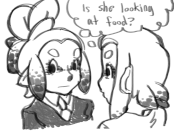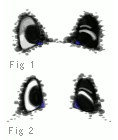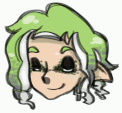
| || |
|
2. Mucomorphosis: Foreign Liquids 3. Pigmentation 4. Lips & Beaks 5. Inkling Mantle Fins 6. Arms & Tentacles 7. Tentacles: Regenerative Abilities 8. Cephaling Masks & Eyes 9. Remaining Features of The Cephalopod To all the Splatoon fans reading this, this is just a fanficticious interpretation rooting from themes of evolution and canon lore (Sunken Scrolls, Alterna Logs, dialogue, etc.) I'm no biologist and I have only a highschool level knowledge of human anatomy. That being said, I'd like it if other Splatoon fans could share their own biological headcanons for these critters. To all the NOT Splatoon fans reading this, the cephaling descends from the real life animal group, the cephalopod. One common race under this branch is known as an Inkling. Cephaling anatomy is pretty vague, and is often speculated about by several fantheorists like me. This piece goes into depth about the evolutionary background of the cephaling, which relies a lot on you having played the games before. Feel free to keep reading though. All original images stylus-drawn by me. If you'd like to read my non-cephaling related theories, scroll down to the bottom. Mucomorphosis & Mesocutation.Cephalopods are invertebrates and will remain invertebrates into the beginning of their cephaling evolution. Anything akin to a bone structure in a cephaling would just be the soft chitinous pen that goes from the base of the neck to inferior of the pectoral region. If inklings could suddenly grow bones, birds would have opposable thumbs by now! Instead, cephalings are just essentially muscle tanks with a flexible sack of organs. There are two forms of transportation enabled by their bodies that a cephalopod can go through: Due to the the modern diets of inkling culture, the average cephaling's ink consistency is so thick that the pressure alone can carry any mass lighter than the body. The popularity of Turf Wars around the world alone pioneered the fashion industry by introducing Inkling-owned fashion brands tailored for sports, to tolerate ink and enhance flow. Notice how inklings and octolings can slip through grates and slide into ropes of metal with complete ease? That's mucomorphosis in action. Mucomorphosis Extended: Foreign Liquids.Mucomorphosis is lethal because of the compulsive consumption of ink. If a cephaling were to submerge itself in any liquid other than ink, two things could happen:
It's typically safe for a cephaling in mesocutation to touch or even swim in water (like when humans hold their noses under water.) Being hooked up to splatting weapons and ink tanks present other dangers i.e. water entering nozzles, tanks, other open ducts leading straight to whatever orifice inking tanks are connected to. It's not really about plain contact, but rather where the water ends up. Pigmentation.As a cephaling matures, they have complete control over their pigmentations and ink, like their skin and tentacles. Limb coloration depends on the placement of the body. Cephaloflagic arms are melanin-deficit. These arms completely reflect the ink pigment the cephaling is producing up until the cephaling's chromatophores mature and the cephaling can control up to 3 colors, including the chromatophores on their clubs, eyemasks, and fingertips. Locomotory limbs like the rest of the body are relatively more melanin-concentrated, but can also be color controlled. The social norm for body-pigmentation tends to be within the range that melanin alone can reach, but some cephalings choose to style themselves in hues achievable only through chromatophores like purple or red. Mucomorphosis is commonly associated with fledglings and younger cephalings when they aren't able to control their inkage, which is what makes turf wars so popular with children. Cephalings in their late hundreds eventually lose the ability to produce/control their inkage, and might even lose the ability to mesocutate, forever in their mucomorphosis form. Lips & Beaks.
The existence of "Splatoon lips" is fucking bizarre and I might never be able to come up with a clear theory for how cephalings evolved to have lips. Cephalings have no reason to need lips if they aren't breastfed, and there's no need for them to evolve to need to be breastfed if they get their nutrients from eggs. However, the Pacific beetle cockroach is an instance in which an insect gives birth and produces milk from a sac, so I've concluded that cephalings are ovoviviparous (the concept of families are evidenced in canon) and the young consume crystalized proteins from a special ink secreted by their mothers afterbirth. Cockroaches don't have lips but I'll take whatever I can to lay rest of what is cephaling reproduction. Along with their lips, cephalings developed a growth beneath their radulas that are functional tongues, but don't sport taste receptors like a regular tongue Early cephaling beaks adapted to have a trapezoidal mandible similar to a mammalian jawbone. The beak's plate commonly has 2-3 nails (4 maximum) on either ridge. Meat from the sea are still a traditional staple of modern Inkling delicacies, but they would have eaten small birds, reptiles, and amphibians within the first generation of Earth's invasion. Inkling Mantle Fins.Speaking of amphibians, the modern inkling's mantle wings are noticeably shrunken from not ever having to use them on land. They resemble human ears, but are about as functional as a drunkard with a lightbulb. Inklings rather have tympanic membranes located right behind the jaw, an external ear drum. Under mucomorphosis, cephalings can interpret ground vibrations to a T. You'd think that means headphones and Cephalo Pods (Forge TM) are purely accessory, but let's put a pin in it and leave it to sound engineers to expand on that. Arms & Tentacles : Locomotory, Cephaloflagic, Mimetic.Cephalings are practically flipped inside-out, upside-down post evolution; their arms sit at the top of their heads, their mantle now a torso with a distinctive neck, and their beaks sit above their eyes. The torso of the average mesocutatious cephaling is brief; the pectoral region is sunken central of the chest. Without a clavicle or pelvis, who needs clothing sizes? Refer below to the 3 categories of cephaling limbs.
 First generation inklings started off with entirely functional tentacles; 4 locomotory and 6 cephaloflagic, directly benefiting the Inklings in the Great Turf War. However before the Great Turf War, Inklings were already facing their own evolutionary phenomenon in which some of their cephaloflagic limbs were now mimetic limbs. Modern inklings have 4 locomotory limbs, 2 cephaloflagic limbs, and 4 mimetic limbs. Modern octolings have 4 locomotory limbs and 4 cephaloflagic limbs total. Tentacles Extended: Regenerative Abilities.Mutilation is in. Inklings are popular for their haircuts because of their mimetic limbs. This is a bit of an Mimetic and cephaloflagic limbs don't possess pain receptors, but have several ink vessels running beneath the muscles. It's established that inklings can control the currents of where ink flows (See: Mesocutation.) As long as an Inkling is not in mucomorphosis, they should be able to handle a clean cut without passing out and losing ink. If an inkling wanted her tentacles back, there are a couple ways she could go about it: she could cut the entire arm off and let it regenerate on its own, or she could graft two of her arms together and let them heal for a week. Shiver's hairstyle and the Inkling girl "bangs" style is a good example of hair grafting. Cephaling Masks & EyesCephalings have camera-type eyes identical yet superior to the human eye. In vertebrates, the nerve fibers protrude over photoreceptor cells because of the optic nerve causing a "blindspot". Cephaling optic fibers on the other hand are hidden behind the photoreceptor cells, allowing them to process every angle that a human can't. Because of their crespucular nature they can process complete darkness, though the cities of Inkopolis and Splatsville don't bend to their wake cycles. Other races live there you know. 
Emotional intelligence plays a role into sclera coloration. The sclera's contrast to the pupil is a survival quality with pros and cons for either orientation; species with black scleras are less likely to be detected alone by their gaze but also less likely to find common ground with others of their own species. Species with white scleras are more easily detectable alone, but are more accepted in social groups. Cephalings for the most part have white scleras and stuck around others with white scleras. Early cephalings and those under isolated/antisocial regimes such as the Octarian army were documented to have green or "dark" scleras, which is pretty consistent with the reality of sclera coloration. The mask is a unique layer of flesh lining the eyes and a result of natural selection. Besides the cephaloflagic limbs and fingers, it's the most melanin-concentrated area of the body. Given that their eyes were originally fit for waters, the dark pigmentation of their masks absorb UV sunrays and benefitted the survival of the first emerging cephalopods. Take a look at the image to the left. 
Figure 2 represents the average octoling's mask pattern. Note the pigmentation in comparison to Figure 1, a representation of the Inkling's average mask pattern. Almost identical if it weren't for the bridge. This could imply the Octarians expanded out to regions that Inklings couldn't pursue because of their quick technological advancements, such as mountains and places with cold climates. Not to mention Octarians were eventually forced to live underground post-GTW, secluded to where "bridge" genes were not environmentally pressured like it was on the surface. The lack of a bridge is a cultural telltale of a cephaling with Octarian blood, though not genetically exclusive to octolings. The Remaining Features of The Cephalopod.Cephalings no longer need suction cups. What's left of those cups are now 5 crater-like digital pads on each locomotory limb and rows of carple knobs and suckers that run from the anterior digital region to the forearm undersides, indicative of a cephaling's maturity stage. Cephaling children typically shed their knobs and suckers at 8 years old, not too unlike a mammalian baby's umbilical cord drying up and falling off. Some Inklings are born with hooks inside of their pads and suctions, a feature that becomes obsolete with each generation but is a legitimate health risk for Inklings. Each inkling for himself chooses to get them surgically removed. For other Splatoon posts: Miscellaneous Splatoon Theories  |
|| |